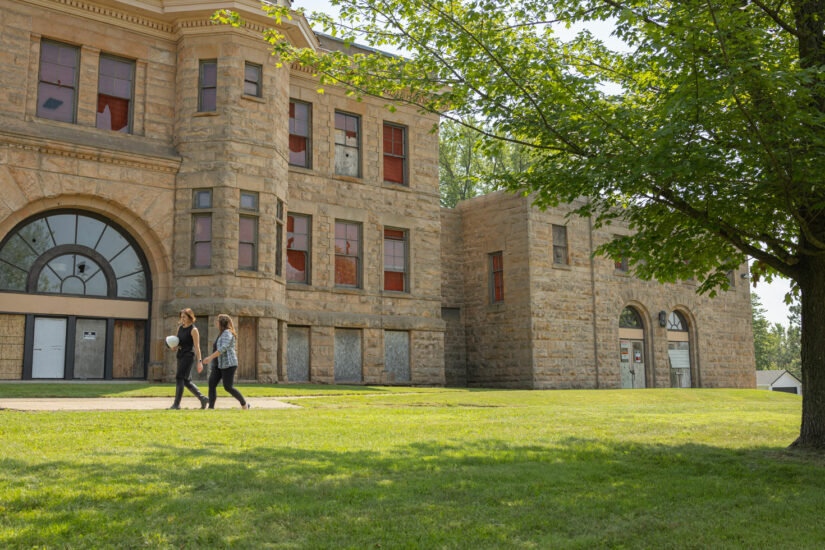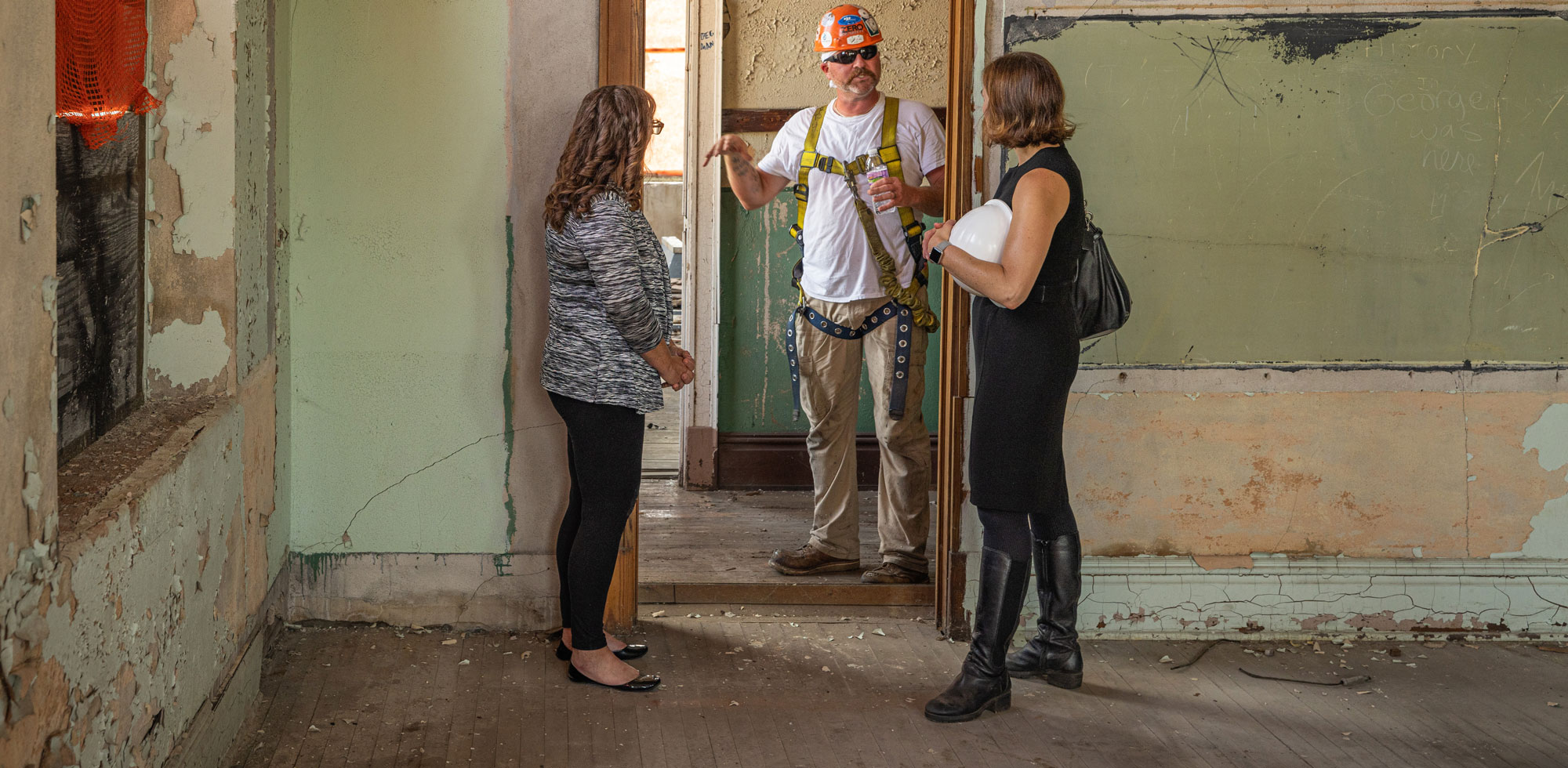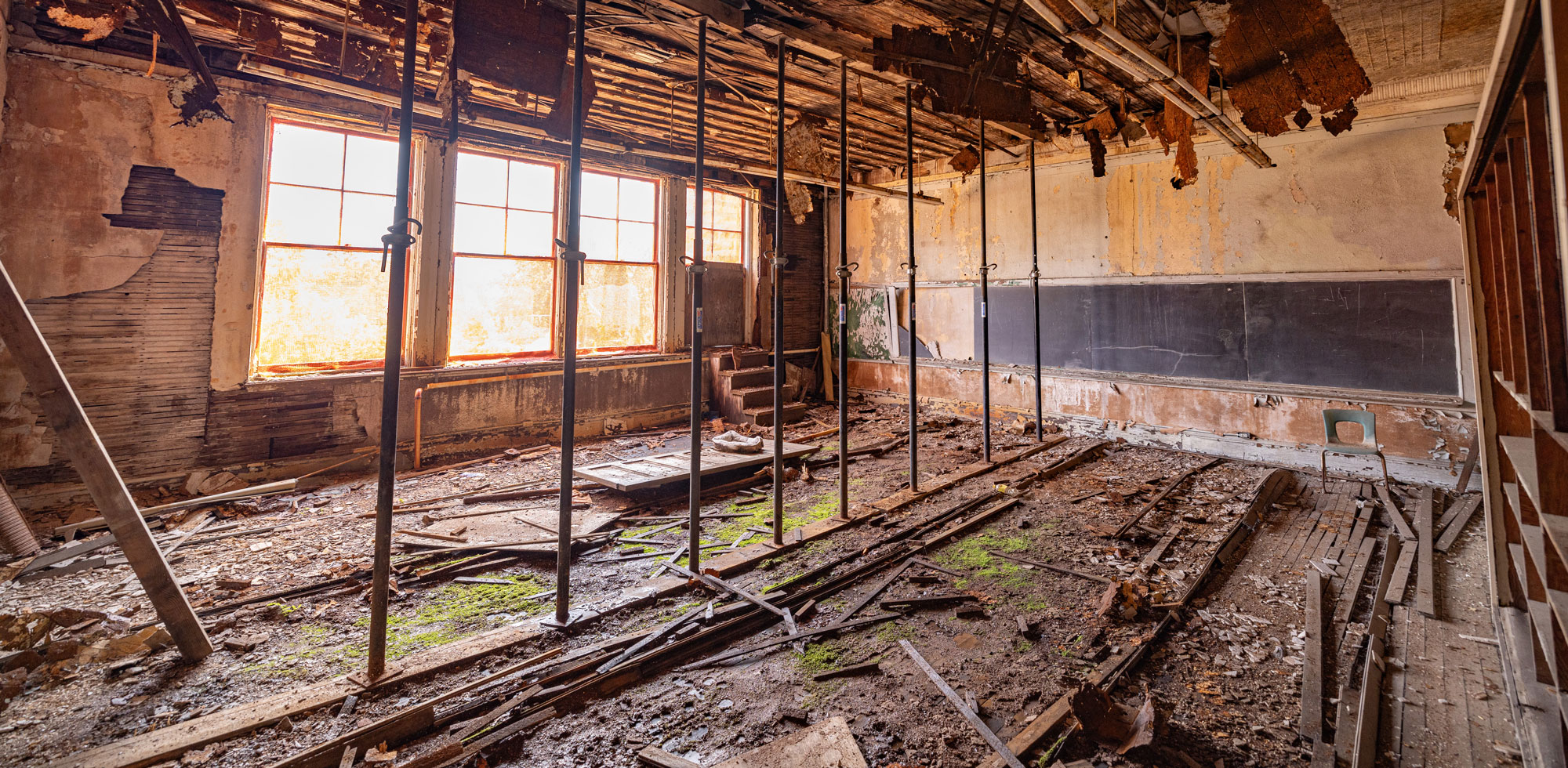
The Sandstone Solution
Communities across the region are in dire need of affordable workforce housing. The city of Sandstone is determined to make a difference.
By Gene Rebeck | Photography by John Linn
Folks around Sandstone call it “The Rock,” and it could soon be ready to roll as a renewed source of workforce housing.
Originally built in 1901, then rebuilt after a 1909 lightning strike, the school was the educational hub for generations of students until 2004 when a combined new school opened 10 minutes away in Finlayson. Constructed of sturdy sandstone harvested from nearby Kettle River quarries, the venerable old structure was named to the National Register of Historic Places in 1979.
“It’s such an iconic building,” said Kathy George, city administrator for Sandstone, which sits about 10 miles north of Hinckley on Interstate 35. “In a town the size of Sandstone, everything happened in that building.” When it was vacated, she said, “it was heartbreaking.”
As the building fell into disuse, and as its role in the community diminished, it fell prey to vandalism and decay. Already unappealing to developers due to the presence of lead paint and asbestos, it fell into further decline as windows were broken, water permeated the roof and leaked into the interior, and mold took hold. Pigeons roosted in its interior while rodents nested in walls and sodden insulation.

ROCK-SOLID POTENTIAL
If all goes to plan, Sandstone School will be converted into 31 affordable apartments: two studios, 10 one-bedroom units, and 19 two-bedroom apartments. The project needs significant funding—and lots of renovation work—before it can welcome residents. Still, prospects for The Rock appear to be on a more solid footing than ever before.
In many respects, the story of The Rock reflects the complicated nature of workforce and affordable housing in Central Minnesota.
THE CONSTRUCTION CONUNDRUM
With high interest rates, rising insurance rates, a tight construction labor market and fluctuating and increasingly expensive materials costs—a simple 8-foot 2×4 costs up to 46 percent more than it did 10 years ago—it’s no simple matter to get low- and moderate-priced housing built in Greater Minnesota or elsewhere. Additional factors have made the challenge even more daunting.
“For years, researchers said there’d be no affordable housing shortage because baby boomers would sell their houses in large enough numbers,” said Don Hickman, vice president for community and workforce development at the Initiative Foundation. “It’s not happening.” There are myriad reasons, including a greater propensity for people to age in place, but other factors include historically high replacement home prices and mortgage rates that are more than double their all-time low of 2.65 percent reached in January 2021.
During the past few years, an acute shortage of workers has exacerbated the problem. It’s attributed to what demographers call a “trough,” where baby boomers are retiring faster than young workers are replacing them. “Our Central Minnesota communities are desperate for workers,” Hickman said. “In some places, we have two jobs for one worker. But if potential workers can’t find housing or lack quality, affordable childcare, it’s next to impossible to attract or retain them.”
Derrick Miedaner, director of policy research and analytics for Flaherty & Hood, a St. Paul-based legislative advocacy firm, has conducted extensive affordable and workforce housing research for the League of Greater Minnesota Cities. The looming issue, he said, is that we’re less efficient in standing up homes than we’ve been in the recent past. Higher material costs, fewer construction workers and industry wage pressures have led to an increase in the cost per housing unit built. “The model we have is broken, and so we need to reassess how we approach housing,” he said.
The Sandstone School project serves as just one example of a new housing model. George said the city cycled through two decades of optimistic possibilities followed by dashed hopes. The city ultimately took ownership of the school building in 2018, hoping to rejuvenate efforts to save the aging structure. “Then, out of the blue,” George said, the city connected with Meghan Elliott.
The founder and principal of Jillpine, a Minneapolis-based historic building redevelopment firm, Elliott has years of experience preserving historic structures. Her background as a consultant and developer was crucial. “Historic buildings are very difficult to redevelop,” George said. “But they can make very good apartment buildings.”
The level of craftsmanship and the construction materials originally used for Sandstone School are hard to replicate, Elliott said. Since the 1970s, however, the federal government has offered tax incentives to repurpose historic buildings that “tend to be more expensive than equivalent new construction.”
The Sandstone School plans call for the original three-story structure and a 1962 two-story addition to be redeveloped. The school’s auditorium, built in 1936, will become home to the Sandstone History and Art Center. Non-historic additions have been demolished.

BUILDING ON PARTNERSHIPS
In 2023, Minnesota Housing, a state agency that funds low- and moderate-income residential projects, received $39 million from the Legislature to fund workforce housing projects with an emphasis on smaller communities. The city and its developer learned in September that they have been awarded nearly $4 million for the school project.
An early investor, the Initiative Foundation leaned in with a $10,000 site-planning grant that ultimately helped the city of Sandstone secure a $675,000 Minnesota Department of Employment and Economic Development (DEED) award. The Foundation followed with a $5,000 grant to help the city draft its Minnesota Housing application. A third grant of $10,000 helped the city explore geothermal as a heating and cooling source.
Repurposing The Rock has garnered additional support from the League of Minnesota Cities and the Pine County Housing and Redevelopment Authority. And, thanks in large part to Elliott’s experience, Sandstone won a grant from the Minnesota Historical Society to put a much-needed new roof on the school this summer.
Thus far, $1.5 million has been invested. “If the current roof remained for another two years, we probably would have lost the building,” George said.
Now, the Initiative Foundation stands ready with a loan of up to $500,000 to help bring the project to completion.
The Sandstone School renovation also has garnered support from the Mille Lacs Band of Ojibwe, which has built two affordable projects of its own. Still in need of workforce housing to support its Grand Casino operations in Hinckley, the band is exploring a management agreement to lease the Sandstone School units through Mille Lacs Corporate Ventures, its business management and development arm.
“The combination of Meghan and Mille Lacs Corporate Ventures opens a lot of doors for this project,” George said.
Construction is expected to begin in earnest during spring 2025 with project completion planned for summer 2026. The Minnesota Housing grant was the last big piece of the puzzle needed for this project to open up partnership financing, Elliott said.
“This grant makes this project feasible,” she said, noting that it will support local workers, their employers and future job growth. “This is an important project for the regional economy.”
HOPE IN HACKENSACK
With a population of just 300, Hackensack is home to Mann Lake Bee and Ag Supply—an anchor business that employs about 600 people. About one-third of those workers trek to the Hackensack headquarters every weekday. “Workers at Mann Lake come from 60 miles around, partly because the wages are so good, and partly because there’s no housing in Hackensack,” Hickman said.
Long plagued by a shortage of housing stock, and backed by a study that demonstrated need, the city of Hackensack in late 2023 purchased property for a project of its own. Working with the Central Minnesota Housing Partnership, a St. Augusta-based nonprofit that provides affordable housing services and management, a group of local leaders put together a plan for Woodland Corners, an apartment building with 30 one- and two-bedroom units. The project’s estimated cost is $7 million, with city supporters kicking in about $1 million and the state providing $2 million. Other funders include Mann Lake, the Blandin Foundation, and the Initiative Foundation.
The housing project has the potential to alleviate some major pinch points: The Hackensack housing study found that workers generally travel 40 miles to get their jobs. Land suitable for housing projects also is scarce, and even though there are 127 lakes within a 10-mile radius, lake home prices are cost-prohibitive for the average local worker.
Supporters were eager to land a Minnesota Housing grant at the end of September, but that award did not materialize. The team is now regrouping and vows to find a new way forward. “We are not deterred,” said Gary Dietrich, team lead of the Hackensack Affordable Housing Program, part of the local Hackensack Game Changers initiative dedicated to enhancing the city. “We have such a great need for housing in the Hackensack area, and we’re going to keep going to find a solution.”
AFFORDABLE HOUSING refers to residential units that are economically accessible to individuals or families with low to moderate incomes. Typically, it means housing costs (rent or mortgage, including utilities) do not exceed 30 percent of a household’s gross income.
WORKFORCE HOUSING refers to affordable housing options targeted at middle-income workers, such as teachers, police officers, and nurses, who earn too much to qualify for traditional affordable housing but struggle to afford market-rate housing. It aims to ensure that essential workers can live near their workplaces.
HOUSING STATS
- Central Minnesota has the highest owner-cost-burden rate in the state, with one in five households spending more than 30 percent of their income on housing.
- Permits for single-family housing in the region decreased by 3 percent from 2022 to 2023, indicating a potential challenge in meeting housing demand.
- There is a scarcity of homes available for renters with extremely low incomes* in Central Minnesota.
Source: 2024 Minnesota Housing Partnership study: mhponline.org/state-of-the-states-housing-2024
*Households defined as extremely low income earn 30 percent of the area’s median income. According to the 2023 American Community Survey, the median household income in Central Minnesota is $71,306.
